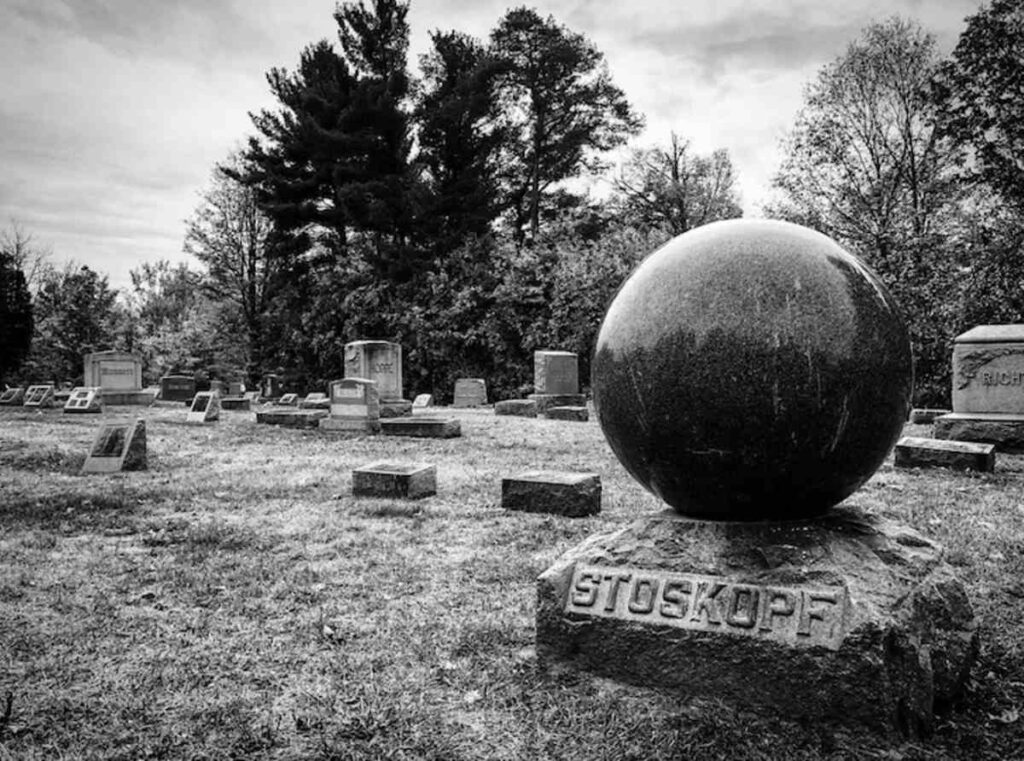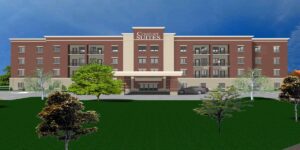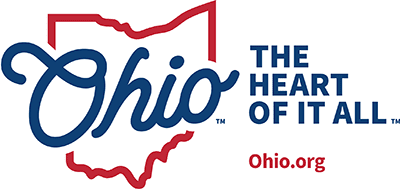
Brunswick Town Center is at the intersection of St. Rt. 303 and St. Rt. 42. Much of the original square was lost in the road widening. On the southeast corner of Rts. 303 and 42 is the Brunswick United Methodist Church. The congregation was formed in 1817 and is the first church in Brunswick. The oldest in Medina County and the second oldest in the Western Reserve region of Ohio. Built in 1872, it is one of Medina County’s earliest churches. The bricks for the original building came from Sherman’s Corner back at Rt. 303 and West 130th. They paid $6.00 per 1,000 bricks. The church tower was added in 1916. The steeple and clarion were added in 1976. On the southwest corner, the Rotary built the clock tower to help define the center of town.
Just west of Brunswick, the large farm house on the north side of Rt. 303 was owned by Captain John Stearns. He owned 1,300 acres and donated the land for Westview Cemetery on the north side of Rt. 303 just past FirstMerit Bank. Sometime in the late 1800’s, one of his family members built the large farm house. It has six rooms on the first and second floor; oak trim work with large slide out oak doors. Much of the sandstone foundation came from his property. The unusual thing is there is a large water tank in the attic which supplied the house with gravity fed running water. When first built, it had a widow’s walk which has been removed.
Liverpool Township is at approximately 770 feet above sea level and is the lowest part in Medina County. The highest point is Hinckley at 1,325 feet above sea level. This intersection was once known as Hardscrabble. This area is also where the first industry was started in Medina County. The Indians had known of a natural salt spring for many years. The story goes that one Indian realizing that Seba Bronson would soon discover the salt springs said he would show him the location if he was paid 5 silver dollars. Seba did not have the money but found someone to go in with him for half. Once shown, they rushed to lay claim, somehow Seba lost out as others also started to boil the salt water down to get salt. The salt producing industry started with 10 kettles and eventually grew to 50. Salt was an important part of processing meat and was very expensive when brought from the east. The area became known as Salt Springs, later changed to Marysville and eventually Hardscrabble. It was said it was named Hardscrabble because of the bitter struggle made by some to gain extra wealth and influence. By 1881, the village was almost deserted. Another part of Medina County later became known for salt. Any guesses?? Wadsworth’s Ohio Salt Company which later
became part of Morton Salt and moved to Rittman just south of Wadsworth.
Myrtle Hill Cemetery will be on the right and is said to be haunted. The round orb head stone is said to roll some nights at midnight.
Liverpool Township first settled in 1810 and has been settling continually since that time. Most likely named after Liverpool, England which also had a salt works. Valley City had a great hunt but it was not as successful as the Hinckley Hunt. They started out with 300 plus men making a very large circle and all moving together and killing the wild animals. It was going well until one of the hunters accidentally hit one of the others when he was chasing a deer. This caused a break in the circle when family members went to see their relative. The break left an open area which many of the hunted animals were able to escape through. The first orchard in the County was planted by Minerva Waner along the east bank of the Rocky River near Hardscrabble. Minerva had brought apple seeds from her home in Connecticut. Once the land was cleared, she planted her seeds in 1812.
Her grandchildren enjoyed the first fruits in 1888. Valley City was laid out in 1845. Early businesses were a foundry which made plows and road scrappers, a woolen factory, flour mill, a washing machine factory and a tannery. In town they had a jewelry store, photography gallery, tin shop, gun shop and bricks and pottery were made near the village. There were also several cheese and cigar factories. In the late 1800’s, Valley City had more industry even more then Medina, the County Seat. In the late 1800’s, it was said there was also an orchard with crab apples southeast of town where they pressed the apples into cider; it was sour yet had a little kick to it. As you come into town on your right will be a train station which was built in 1888 east of town on Rt. 303 and moved to this site. It now has a train in the front and is home to the Historical Society and is used for Town Hall meetings. The United Church of Christ on the left was built in 1869. It has its original double doors, stain glass lights and a round rose window. The octagonal steeple with arched belfry are unique in Medina County.
This is now home to the Valley City Frog Jump every August. You can bring your own frog or rent one from the festival and compete to be the frog with the longest jump.
On the right side, the Town Hall in the early 40’s through the 60’s would show movies. Also on the right side is Riverstone Tavern. This will make a great stop for lunch.
As you drive west on Rt. 303 out of town, you will see several brick homes. These were built in the 1850’s and 1860’s. All had separate builders but are all built in the same style. Greek Revival often referred to as the Western Reserve Style. Red brick with stone lentals and decorative doorways. At the corner of Rt. 303 and Station Road are two homes. On the southeast corner is the home built by Charles Franks in 1857. This served as a home, general store and stage coach inn. The two entrances divide the home from the commercial side on the northwest corner is the home of William Strosaker. Built in the 1880’s, his son, Dr. Charles Strosaker was the founder of Dow Chemical. The home is a mix of Italianate and Gothic Revival Style.
Almost at the county line on the left will be Hill Haven Greenhouse. The garden center is known for its water plants. It is a great place to get help when planning a water feature at your home. Also are flowers, gifts and the staff are ready to help with all your gardening needs. Also Hill Haven Antiques is at this location. Call to make sure they are open if you are going out for antiques.
As you travel south, you will see the spire of St. Martin of Tours Catholic Church. The congregation was started in the 1840’s, six years before the Catholic Diocese of Cleveland was established. The church was started in 1860. The congregation had out grown their first church and decided to build a new one. Each man in the congregation promised a year to construct the church. The bricks were fired from clay found within a 1/2 mile of the church.
The story is that in the spring of 1860, the men all plowed and planted their fields. Then left them to God to tend as they all built the church. It is said that they had the best harvest on record that fall when they returned to harvest their fields. The exterior was completed in 1861 with the interior taking another 20 years. Making this the oldest church building in Medina County. The tower is 164 feet, the cost for both $30,000. In 1894 the pastor residence was built. In 1957 the rectory was expanded and in 1965 the new parish center was built. Today, they have built a new sanctuary. In the back behind the cemetery they have a park-like setting for the stations of the cross. This is where they do a prayer at each of the 14 passions.
A short way down the road on the right will be Beriswill’s Farm Market. They offer fresh vegetables, natural and organic meats including Bison. Hope you have a cooler to take home some great food for fresh meals.
Just a little way down is Medina County Parks Lester Rail Trail. This park is the starting point for the 3.5 mile walking trail. The park is also home to the Northern Ohio Live Steamers that has a small scale train for rides for kids and family. Check the parks website (www.medinacountyparks.com) for dates the Live Steamers is open to the public. Just before turning left onto Norwalk Road, the York Town Hall will be on your left.
This is the home of the York Historical Society. They are open the second Sunday of each month from 2-4pm or by appointment. A oneroom schoolhouse is the where historical items can be found. Also a granary and timber frame barn with antique implements.
On the left will be Buckeye High School, Middle and Elementary School. At the intersection of Wolff Rd, just past the schools is the Medina County District Library Branch on the left.
At the corner of Abbeyville and Hamilton, on the southeast lot is a white house which used to be the Abbeyville Ball Diamond. It was built in the 1930’s and was used until 1985 when the home was built about where the pitcher’s mound was. The area farmers put a team together and would play
other teams here.
You will see Zion Lutheran Church. Built on top of a prominent hill overlooking the river. Similar in design to St. Martin’s, the cornerstone was laid in 1894 and the church completed in 1896 with only a 107 foot tower.
On the left side (1496 Columbia Rd) will be Jilbert Winery. Established in 1999, it is a family owned and operated boutique winery offering a variety of wines but specializing in the production of a unique product known as Honey Wine. The winery is housed in a historic dairy barn built in 1905. The property also includes the historic home built in 1913. They serve a weekly changing chef’s table menu weekends March thru December. At the corner of Rts. 303 and 252 will be a Stop’nGo Convenience Store and Marketplace where you can fill up with gas and get a quick snack before heading east on Rt. 303 to I-71.







